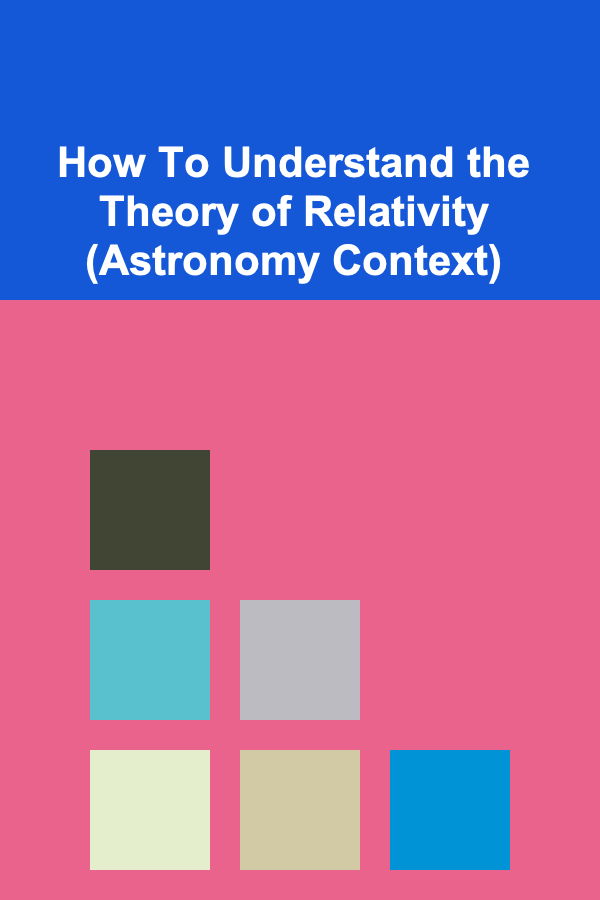
How To Understand the Theory of Relativity (Astronomy Context)
ebook include PDF & Audio bundle (Micro Guide)
$12.99$8.99
Limited Time Offer! Order within the next:

The theory of relativity is one of the most profound and revolutionary scientific concepts ever introduced to humanity. First proposed by Albert Einstein in the early 20th century, it fundamentally altered our understanding of space, time, gravity, and the very fabric of the universe. There are two primary components to the theory: special relativity and general relativity. Both of these theories have had a tremendous impact on astronomy and our view of the cosmos. Understanding them in the context of astronomy requires an exploration of their core principles, their relationship with the universe, and their far-reaching implications for our understanding of space and time.
In this article, we will dive deep into the theory of relativity, discussing the key ideas behind both special and general relativity, how they relate to astronomical phenomena, and the way they have reshaped modern astronomy.
The Birth of the Theory of Relativity
Before Einstein, the laws of physics, particularly Newtonian mechanics, were considered the gold standard for understanding the motion of objects and the forces acting upon them. Newton's laws of motion and his theory of gravitation worked remarkably well in explaining a wide variety of phenomena, especially for objects on Earth or moving at relatively low speeds. However, there were notable problems with applying Newton's framework to objects moving at speeds close to the speed of light or in the presence of extremely strong gravitational fields.
This is where Einstein came into play. Einstein's special theory of relativity, proposed in 1905, laid the groundwork for his more expansive general theory of relativity, published in 1915. Both of these theories revolutionized our understanding of space and time, which had previously been regarded as separate, absolute entities.
1.1 The Limits of Newtonian Physics
Newton's laws assume that space and time are constant and independent of any external influences. This worked well for centuries, but as the understanding of the universe expanded, issues arose when considering objects moving at high velocities or the effect of intense gravitational forces.
One of the biggest challenges was the speed of light. According to Newtonian mechanics, speeds are additive --- if one object is moving at 5 meters per second and another at 10 meters per second in the same direction, their combined speed should be 15 meters per second. However, Einstein's observations led to the realization that this was not true for the speed of light. No matter how fast you move relative to a light source, light always travels at the same speed (about 299,792 kilometers per second) in a vacuum, regardless of your motion.
Special Relativity: The Foundation of Relativity
Einstein's special theory of relativity (1905) provides the foundation for understanding how objects behave at speeds approaching the speed of light. The theory rests on two fundamental postulates:
- The laws of physics are the same for all observers, regardless of their relative motion.
- The speed of light in a vacuum is constant for all observers, regardless of their relative motion.
These principles led to several key results that challenge our intuition about space and time.
2.1 Time Dilation
One of the most famous consequences of special relativity is time dilation. According to the theory, as an object approaches the speed of light, time for that object slows down relative to an observer at rest. This means that a person traveling at a significant fraction of the speed of light would age slower than someone who remains stationary. This phenomenon, although counterintuitive, has been experimentally verified using precise clocks on fast-moving airplanes or satellites.
In an astronomical context, this effect becomes significant for objects moving at high velocities, such as particles in cosmic rays or spacecraft traveling to distant planets. Time dilation also has implications for how we interpret the behavior of objects moving close to the speed of light, like neutron stars or black holes, where relativistic speeds are commonly encountered.
2.2 Length Contraction
Another mind-bending consequence of special relativity is length contraction. When an object moves at a high velocity relative to an observer, its length along the direction of motion appears shorter to the observer than it does at rest. This effect only becomes noticeable at speeds close to the speed of light. Astronomically, this effect helps explain the behavior of fast-moving particles and jets emitted from black holes and active galactic nuclei.
2.3 Relativity of Simultaneity
Special relativity also introduced the idea that simultaneity is relative. In other words, two events that appear to happen at the same time for one observer may appear to happen at different times for another observer moving at a different velocity. This concept is central to understanding the nature of time in relativistic contexts, such as when studying light curves of distant stars or the behavior of cosmic phenomena.
2.4 Mass-Energy Equivalence
Perhaps the most famous equation derived from special relativity is E = mc², which expresses the equivalence of mass and energy. This equation tells us that mass can be converted into energy and vice versa. This insight has profound implications for both theoretical and observational astronomy. It explains the energy released in nuclear reactions within stars and provides the foundation for understanding processes like nuclear fusion and the energy produced in supernovae and black hole formation.
General Relativity: Gravitational Waves and Curved Spacetime
While special relativity addresses objects moving at constant velocities, general relativity extends the theory to include gravity and accelerated motion. General relativity, published by Einstein in 1915, fundamentally changed the way we think about gravity. Instead of viewing gravity as a force transmitted through space, Einstein proposed that gravity is a result of the curvature of spacetime caused by massive objects.
3.1 Spacetime and Gravity
In general relativity, gravity is not seen as a force in the traditional Newtonian sense. Instead, massive objects cause the fabric of spacetime to curve, and objects move along the curves in spacetime. This concept is often illustrated using the analogy of a heavy ball placed on a rubber sheet: the ball creates a depression, and smaller objects roll toward it. In this analogy, the rubber sheet represents spacetime, and the ball represents a massive object like a star or planet.
In the context of astronomy, general relativity helps explain the behavior of planets, stars, and galaxies in ways that Newtonian gravity cannot. For example, the orbit of Mercury, which could not be accurately explained using Newtonian physics, is perfectly accounted for by general relativity.
3.2 Gravitational Lensing
One of the most direct ways general relativity manifests in astronomy is through gravitational lensing. This phenomenon occurs when light from a distant object, such as a galaxy or quasar, passes near a massive object (like a galaxy cluster or black hole), causing the light to bend. The bending of light due to the curvature of spacetime creates distorted, magnified, or multiple images of the distant object. Gravitational lensing has become a powerful tool in modern astronomy for studying the distribution of mass in the universe, including dark matter.
3.3 Gravitational Waves
Perhaps one of the most exciting discoveries of the 21st century was the detection of gravitational waves. These ripples in spacetime, predicted by Einstein in 1915, are caused by the acceleration of massive objects, such as the collision of two black holes or neutron stars. Gravitational waves travel at the speed of light and carry information about their sources, providing astronomers with a new way to observe the universe.
The first direct detection of gravitational waves came in 2015, when the Laser Interferometer Gravitational-Wave Observatory (LIGO) recorded waves from the merger of two black holes. This discovery opened up a new era of multimessenger astronomy, where astronomers can study the universe through a combination of electromagnetic waves (light, radio, etc.) and gravitational waves.
3.4 Black Holes and Singularities
General relativity also predicts the existence of black holes, regions of spacetime where gravity is so strong that not even light can escape. The theory suggests that when a massive star collapses, it can form a singularity---a point of infinite density. The event horizon surrounding a black hole marks the boundary beyond which nothing can escape. The study of black holes, particularly supermassive black holes at the centers of galaxies, has become a cornerstone of modern astronomy, and recent imaging of a black hole's event horizon by the Event Horizon Telescope has provided a stunning confirmation of general relativity in action.
Relativity in the Cosmos: Key Observational Evidence
The theory of relativity has been extensively tested in the context of astronomy, and its predictions have been confirmed through numerous observations.
4.1 Orbital Mechanics
The motions of planets, moons, and artificial satellites are all influenced by the curvature of spacetime, and their orbits provide strong evidence for general relativity. For example, the precession of Mercury's orbit, a small but significant deviation from the Newtonian prediction, is precisely explained by general relativity. Similarly, the GPS system, which relies on satellites orbiting Earth, must account for relativistic time dilation effects in order to provide accurate positioning data.
4.2 Cosmological Models
General relativity forms the basis for our understanding of the large-scale structure of the universe. The Friedmann equations, derived from Einstein's field equations, describe the evolution of a homogeneous and isotropic universe. These equations form the foundation of the Big Bang model and our current understanding of cosmology, including the expansion of the universe and the cosmic microwave background radiation.
4.3 Dark Matter and Dark Energy
General relativity also plays a crucial role in understanding the mysteries of dark matter and dark energy. While general relativity explains the gravitational effects of visible matter, discrepancies in galactic rotations and the behavior of galaxy clusters suggest the existence of unseen matter, known as dark matter. Similarly, the accelerated expansion of the universe, attributed to dark energy, is best explained through the framework of general relativity, particularly with the introduction of the cosmological constant.
Conclusion: The Ongoing Legacy of Relativity
The theory of relativity has profoundly altered our understanding of the universe. From time dilation to gravitational waves, from black holes to the expansion of the cosmos, relativity provides the framework for understanding the most fundamental aspects of the universe. Its applications in astronomy continue to shape the way we observe and interpret the cosmos.
As our observational tools become more sophisticated, such as with the advent of gravitational wave astronomy and next-generation telescopes, the theory of relativity will continue to be a guiding force in unraveling the deepest mysteries of the universe. Whether we're studying the motions of galaxies, the birth and death of stars, or the nature of spacetime itself, relativity remains the cornerstone of modern astrophysics.

How to Master Industrial Interior Design
Read More
How to Profit from Deep Learning by Building AI-Based Products
Read More
How to Use the KonMari Method for a Clutter-Free Home
Read More
The Performance Marketing Manager's Playbook: Strategies for Data-Driven Success
Read More
How to Cultivate Unconditional Love
Read More
Finding Adventure in the Canyons of Colorado
Read MoreOther Products

How to Master Industrial Interior Design
Read More
How to Profit from Deep Learning by Building AI-Based Products
Read More
How to Use the KonMari Method for a Clutter-Free Home
Read More
The Performance Marketing Manager's Playbook: Strategies for Data-Driven Success
Read More
How to Cultivate Unconditional Love
Read More